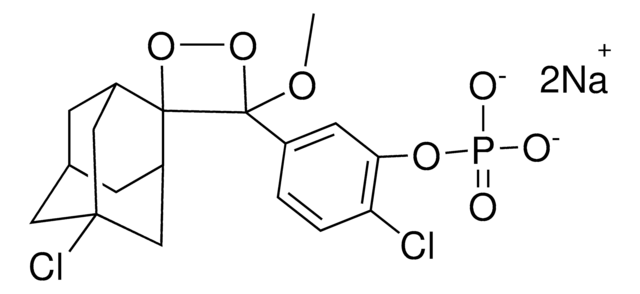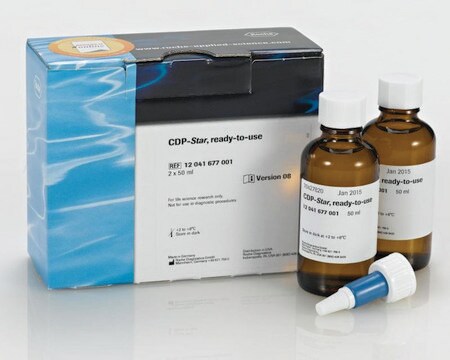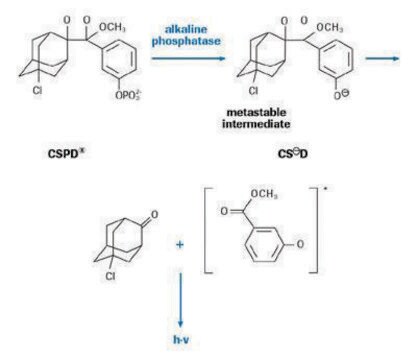CDP-RO
Roche
CDP-Star®
Disodium 2-chloro-5-(4-methoxyspiro {1,2-dioxetane-3,2′-(5′-chloro)tricyclo[3.3.1.13,7 ]decan}-4-yl)-1-phenyl phosphate
Sinonimo/i:
CDP-Star® Chemiluminescent Substrate, ready-to-use, cdp-star, Disodium 2-chloro-5-(4-methoxyspiro[1,2-dioxetane-3,2′-(5-chlorotricyclo[3.3.1.13.7]decan])-4-yl]-1-phenyl phosphate
About This Item
Prodotti consigliati
Livello qualitativo
Saggio
>98%
Forma fisica
solution
Confezionamento
bottle of 1 mL (11685627001[25 mM])
bottle of 2 × 1 mL (11759051001[25 mM])
Produttore/marchio commerciale
Roche
Condizioni di spedizione
wet ice
Temperatura di conservazione
2-8°C
Stringa SMILE
Cl[C@]1(C2)C[C@H]3C4(OOC4(C5=CC(OP([O-])([O-])=O)=C(Cl)C=C5)OC)[C@@H]2C[C@@H](C1)C3
InChI
1S/C18H21Cl2O7P.2Na/c1-24-18(14-6-13(2-3-15(14)19)25-28(21,22)23)17(26-27-18)11-4-10-5-12(17)9-16(20,7-10)8-11;;/h2-3,6,10-12H,4-5,7-9H2,1H3,(H2,21,22,23);;/q;2*+1/p-2/t10-,11-,12+,16-,17?,18?;;
UKWLRLAKGMZXJC-VCCHNUGISA-L
Cerchi prodotti simili? Visita Guida al confronto tra prodotti
Descrizione generale
25 mM solution (12.38 mg/ml), 100x concentration
Applicazioni
- Southern blot
- Northern blot
- Dot blot
- Colony and plaque hybridization
- Gel shift assays
Caratteristiche e vantaggi
- Save time with a fast, ultra-sensitive substrate.
- Easily strip and reprobe membranes.
- Take multiple exposures of up to two days for each experiment.
- Reuse the substrate by filtering and storing in sodium azide.
Qualità
Nota sulla preparazione
Maleic Acid Buffer: 15 to 25 °C, stable
Detection Buffer: 15 to 25 °C, stable
Blocking Solution: always prepare freshly
Antibody Solution: 2 to 8 °C
Altre note
- First exposure to X-ray film should be 5-15 minutes. Examine film and then determine other exposure times based on initial result.
- No preincubation step required.
- Apply substrate quickly to avoid gray shadows from substrate drops and drying of membrane (leads to uneven, high background).
- Do not use plastic wrap to cover blot; use hybridization bags, acetate sheet protectors, or two sheets of transparent film.
- Exposure times are shorter than with CSPD.
- Do not use nitrocellulose membranes.
- Repeat exposures can be made up to two days after the addition of substrate.
Note legali
Prodotti correlati
Codice della classe di stoccaggio
12 - Non Combustible Liquids
Classe di pericolosità dell'acqua (WGK)
nwg
Punto d’infiammabilità (°F)
No data available
Punto d’infiammabilità (°C)
No data available
Certificati d'analisi (COA)
Cerca il Certificati d'analisi (COA) digitando il numero di lotto/batch corrispondente. I numeri di lotto o di batch sono stampati sull'etichetta dei prodotti dopo la parola ‘Lotto’ o ‘Batch’.
Possiedi già questo prodotto?
I documenti relativi ai prodotti acquistati recentemente sono disponibili nell’Archivio dei documenti.
I clienti hanno visto anche
Il team dei nostri ricercatori vanta grande esperienza in tutte le aree della ricerca quali Life Science, scienza dei materiali, sintesi chimica, cromatografia, discipline analitiche, ecc..
Contatta l'Assistenza Tecnica.


![CSPD ready-to-use Disodium 3-(4-methoxyspiro {1,2-dioxetane-3,2′-(5′-chloro)tricyclo [3.3.1.13,7]decan}-4-yl)phenyl phosphate](/deepweb/assets/sigmaaldrich/product/images/352/091/ef743cea-ccd8-44f1-8f3b-dec5a1e4f5d1/640/ef743cea-ccd8-44f1-8f3b-dec5a1e4f5d1.jpg)







